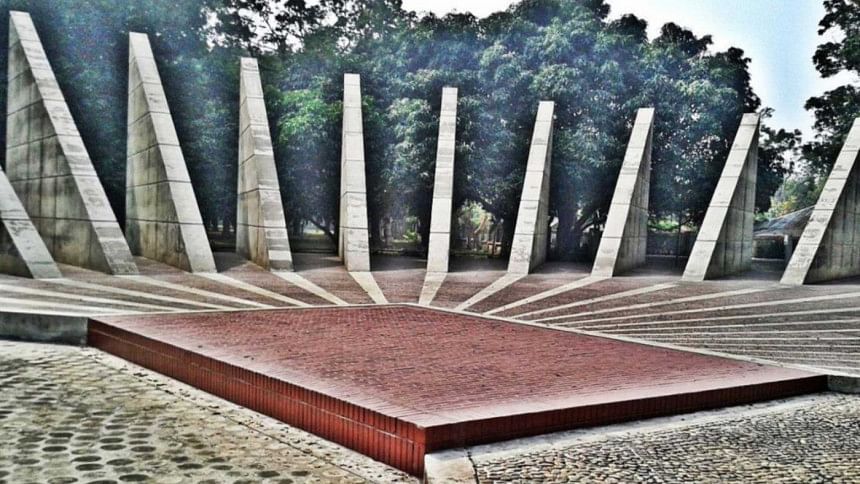Mujibnagar Day: How the Mujibnagar government turned the dream for freedom into reality

Geographically, Plassey and Baidyanathtala are quite close to one another. Both are also significant in the history of Bengalis. One is a place of failure and disappointment, the other a place of accomplishment. Bengalis lost their independence at the mango grove of Plassey, and took an oath to regain it at the mango grove of Baidyanathtala.
Bangabandhu Sheikh Mujibur Rahman declared the independence of Bangladesh on March 26, 1971. The last person to meet Bangabandhu that night was journalist Ataus Samad. Bangabandhu told him: "I have given you independence. Now go and preserve it. The party cadres have been told what to do and the resistance has begun." (Afsan Chowdhury, 1971: Memories, Facts, and Words Overheard, Strategic Analysis).
Following that, the establishment of Bangladesh as a sovereign people's republic was officially announced on April 10. This declaration endorsed Bangabandhu's declaration of independence. Then, on April 17, the cabinet of a newly-formed government headed by Syed Nazrul Islam, as acting president, and Tajuddin Ahmad, as prime minister, was sworn in at Baidyanathtala. Since then, this place has been known as Mujibnagar, this day as the Mujibnagar Day, and this government as the Mujibnagar government.
Undoubtedly, the significance of the Mujibnagar Day is far-reaching, which can be understood from the comments of US Senator Edward Kennedy. He compared Mujibnagar to Philadelphia, where the American Declaration of Independence was adopted. To grasp its true significance, it is crucial to understand the importance of the resolutions proposed, passed, and acted upon regarding Bangladesh between March 31 and April 10, 1971. At the same time, it is also imperative to know how the outcomes of discussions held between Awami League leaders and Indian Prime Minister Indira Gandhi were conducive to the establishment of the Mujibnagar government.

Immediately after the brutal attacks by Pakistani military on March 25, the leaders of Awami League and its associated organisations crossed the border of India to prepare for the war of liberation. Tajuddin Ahmad appeared on the border of West Bengal on the evening of March 30 and Sheikh Fazlul Haque Mani, along with other leaders of the Awami Youth League, arrived in Kolkata in the first week of April. Soon after, Syed Nazrul Islam, AHM Qamaruzzaman, Captain Mansur Ali, and others also reached the border. Although it wasn't apparent at the beginning, a definitive course of action to achieving the goals of the Liberation War was taking shape in the minds of these leaders, which later was adopted as the strategy of the Mujibnagar government. And that is—"first self-defence, then prepare and finally attack."
According to experts, in general, there are three main prerequisites for the successful conduct of any liberation war: 1) to have broad support of the people and the party in the leadership; 2) to confirm safe havens for conducting training for freedom fighters; and 3) to ensure a regular supply of weapons and other equipment.
The first prerequisite was confirmed through the outcome of the 1970 general election. The second and third conditions required the cooperation of the government of India. Although at the request of Bangabandhu, the assurance of India's assistance and cooperation was confirmed by the Indian Deputy High Commissioner in Dhaka on March 17 (Maidul Hasan, Muldhara Ekattor), its implementation was urgent. The second and third conditions were inextricably linked. After reaching the border of West Bengal, Tajuddin Ahmad contacted the Indian border administration. Since then, things moved very fast. The Indian administration arranged for Tajuddin to go to Delhi for talks with Indira Gandhi, and they met on April 4.
During the meeting, Tajuddin requested the formation, training, and allocation of arms to freedom fighters based on the assurance of assistance given to Bangabandhu through the Deputy High Commissioner in Dhaka. Indira Gandhi wanted to know whether Awami League had already formed a government-in-exile. If formed, "Mrs Gandhi wanted to ascertain whether their [Tajuddin and Aminul Islam's] proposition had Mujib's concurrence" (Maidul Hasan, Muldhara Ekattor). Not only that. India wanted to ensure that the leadership to fight Pakistan has broad-based support of all the groups and they should be acceptable to the people of East Pakistan. At the same time, Delhi wanted Awami League leaders to demonstrate "the ability of Mujibnagar government to establish their legitimacy in the eyes of the world" (Jairam Ramesh).
It can be noted that before the Indira-Tajuddin meeting, the Indian government took two significant decisions concerning the Liberation War of Bangladesh.
First, endorsing a resolution on the brutalities of Pakistan military. On March 31, the Indian parliament passed a unanimous resolution presenting to the world a picture of Pakistan military's attacks on the civilian population of Bangladesh. It reads as follows: "This House calls upon all peoples and governments of the world to take urgent and constructive steps to prevail upon the government of Pakistan to put an end immediately to the systematic decimation of people which amounts to genocide… wishes to assure them that their struggle and sacrifices will receive the wholehearted sympathy and support of the people of India."
Second, a decision was taken in early April to keep India's borders open for the people of the war-torn country and to grant Bangladesh's government-in-exile the right to conduct political activities within Indian territory.
These decisions played a pivotal role in the establishment, operation, and management of the Mujibnagar government.
Returning from Delhi, Tajuddin, without delay, focused on forming the government based on the discussions he had with Indira Gandhi. The establishment of Bangladesh as a sovereign country was officially declared on April 10, and on April 17, the new government was sworn in. The formation of the Mujibnagar government is considered the right constitutional, logical and practical step towards the full realisation of our dream for independence. From this point of view, Mujibnagar Day is a landmark chapter in our history, the significance of which is far-reaching. Let me explain further.
Establishing legitimacy for the Liberation War in the eyes of the world
It was critical to demonstrate to the rest of the world that the Liberation War of Bangladesh was a peoples' war, following an extended phase of a democratic movement—not a separatist attempt of an obscure section of the population—and also to show that the leadership had broad-based support from all walks of life in the fight against the Pakistani junta. These were made possible through the establishment of the Mujibnagar government. Establishing the legitimacy of the war in the eyes of the world was fundamental for both the Mujibnagar government and the Indian government.
We must remember that it was a time when the Cold War between the Western world and the socialist block was at its height. Although many countries expressed solidarity with our struggle and extended a helping hand, the United States and China took a stand against the independence movement of Bangladesh. The Nixon-Kissinger administration was determined to maintain Pakistan's unity at all costs. On the other hand, Kissinger opined that the Awami League and Bengalis were politically left (Gary Bass, The Blood Telegram). In such a situation, any wrong turn by the Mujibnagar government could have thwarted the rightful peoples' war of national emancipation as a separatist movement. That is exactly why the long struggle of the IRA, the Basque Country movement in Spain, and the Tamil Tigers movement have been ruined.
Establishing control over the Liberation War
If the formation of the Mujibnagar government was delayed, it is certain that a guerrilla-style war would have spread across the country without any central control. It can be recalled that following Bangabandhu's March 7 speech, "high commands" were formed in every district under the leadership of Awami League. After the crackdown on March 25, these commands put up a resistance with guerrilla tactics. To reach the desired goal, however, coordinating and controlling these sporadic freedom fighters' groups was an absolute necessity. This was made possible only through the establishment of the Mujibnagar government. Ultimately, these combatants emerged as the mainstream freedom fighters. In short, in the absence of the Mujibnagar government, an uncoordinated and uncontrolled independence struggle would have been marked as a separatist movement, and possibly doomed to failure.
Partitioning the battlefields and organising the fighters
On March 25, apart from the Awami League leaders and workers, university students and teachers, Pakistan's targets were Bengali soldiers and officers of East Pakistan Rifles (EPR) and the Bengal Regiment. As soon as the EPR and the Bengal Regiment came under attack, a vast majority of officers and troops took part in the mutiny and resistance war. This was spontaneous, however unplanned. Due to the establishment of the Mujibnagar government, it was possible to organise them by bringing them under a single chain of command.
The establishment of the government is thus a milestone in our history that gave life and legitimacy to our independence fight. The nation remembers with gratitude those leaders who led the war with great resolve and efficiency in the absence of the Father of the Nation.
Dr Shams Rahman is a professor at the Department of Supply Chain and Logistics in RMIT University, Melbourne, Australia.

 For all latest news, follow The Daily Star's Google News channel.
For all latest news, follow The Daily Star's Google News channel. 



Comments